Imagine you just witnessed the greatest video you’ve ever seen.
A few days later, you’re having coffee with a friend, and you tell them they’ve got to watch the video. You search YouTube, but you can’t remember the exact title.
In fact, it might not even be on YouTube. Was it on Tumblr? Maybe it was Facebook. But which group? No, Reddit. But which sub?
Now imagine your company’s entire branding campaign rests on that video. If you can’t find it, it will be a disaster.
Far too many companies have their most important text files, pictures, videos, audio files, rich media assets, and more — their digital assets — floating around and when crunch time comes, they can’t find what they need.
But there may be a solution to this chaos: digital asset management (DAM).
What is digital asset management?
Digital asset management means taking all the assets critical to your brand and storing them in a single, searchable location.
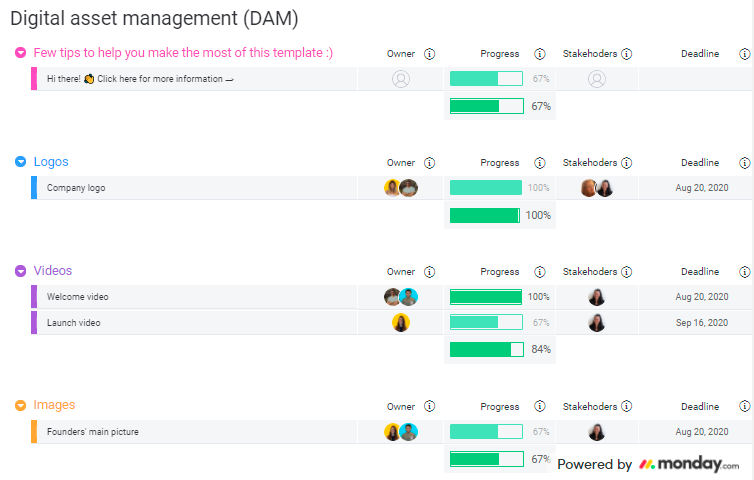
To truly understand digital asset management, it’s best to consider each of the 3 words on their own, then put them all together.
Digital, of course, means anything that exists online.
A digital asset is any piece of digital content, plus the metadata that explains what it is and how to use it. A digital asset can be a text-based digital file, sound file, picture, video, interactive media, or multimedia.
Management, in this case, refers to data management: the act of cataloging and storing data in a safe place so you can find it again later.
While asset management is as old as a business, digital asset management is just a natural evolution.
A wide variety of services fall under the umbrella of a DAM system: acquiring digital assets, organizing them, cataloging their metadata, protecting them from damage, loss, or theft, and retrieving them on command.
If someone in your company needs an infographic for the website, for example, they may go to the digital asset manager, who knows exactly where to find it.
These days, the term “digital asset manager” is also likely to refer to DAM software. The simplest digital asset management software handles databases. Some more powerful apps can automate storage and retrieval, or let managers edit digital assets in the database.
Security features are critical since a great many digital assets are proprietary. Some databases allow managers to sell digital assets to customers.
As digital assets become increasingly important to marketing in every industry, there’s a growing demand for digital asset management that’s more customizable, adaptable, and user-friendly.Before we get into use cases, though, let’s address another question: why exactly is all of this so important?
Why is digital asset management important?
The digital asset management market made $2.96 billion in 2020. By 2026, it’s expected to be worth over 3 times as much.
So, where is all that demand coming from?
Simple: it’s worth it.
An effective DAM solution can save a company huge amounts of money. Poor asset management restricts growth, but good asset management can propel it forward.
Suppose you pay an employee $25 per hour. That employee spends 8 hours creating a piece of digital content for your latest marketing campaign, stores it on their hard drive, then goes home for the weekend.
On Monday, you discover that a power surge fried that employee’s computer. The digital content is gone. They have to spend another 8 hours recreating it and rebuilding the metadata from scratch.
The $200 you paid them to create it the first time is lost — a direct financial cost of poor digital asset management. With a central database, you could have retrieved the lost asset before finishing the coffee you walked into work with.
Even without one-off disasters, failing to centralize your assets can cost you dearly.
Very few organizations can get by without online content these days. The more a company grows, the more content it puts into circulation. All this content needs to maintain brand consistency and accuracy.
It’s called the digital bottleneck, and it’s like a lead weight for growth.
Without digital asset management, your ability to inspect every piece of content is severely curtailed. Either you artificially limit the amount of marketing you can do, or sooner or later, you’ll put out something embarrassing–like a video that names the wrong year, or an infographic so low-res it turns into a meme.
And when everything is going right, you’re still slowing your operations down. Your creatives are stuck answering requests for digital assets instead of, you know, creating.
The requests come from other creators, other teams, partners, and clients.
Wouldn’t it be easier if all those people could get their assets from one self-serve location and know they were compliant with the company’s latest branding strategies?
This is exactly why digital asset management is important.
There’s one more thing we have to cover here: security.
When your organization depends on intellectual property in the form of digital assets, cyberattacks represent an apocalyptic risk to your bottom line. These attacks can even come from within your team.
Most attacks start with a specific employee’s identity being stolen and gradually move on to other data employees have access to.
Yet Varonis reports that 64.3% of all companies have over 1,000 digital files that any employee can freely access.
A digital asset management system isn’t just a library. It’s also a vault. With the right manager, you can enjoy the reassurance of backing up your digital assets on the cloud, without worrying about a potential hacker getting at them.
What are some examples of digital asset management?
If you’re still not sold on digital asset management, we’ve gathered 7 use cases in this section.
Read on — chances are at least 1 of these applies to you.
1. Centralize all your branding
In the last section, we described an organization with a creative staff too busy to do their jobs.
How could they get to that point? Through a series of decisions that all seemed like good ideas at the time.
The people creating digital assets should also know where they’re stored and which ones are up-to-date. They’re the natural people to ask. But in practice, this means they spend most of their time digging for digital assets or metadata other people need.
By storing all the most important aspects of your brand in a single location, you can streamline your content creation lifecycle.
When someone is assigned to build a digital asset, they’ll have all the starting components at their fingertips. This saves time and makes sure you maintain brand consistency.
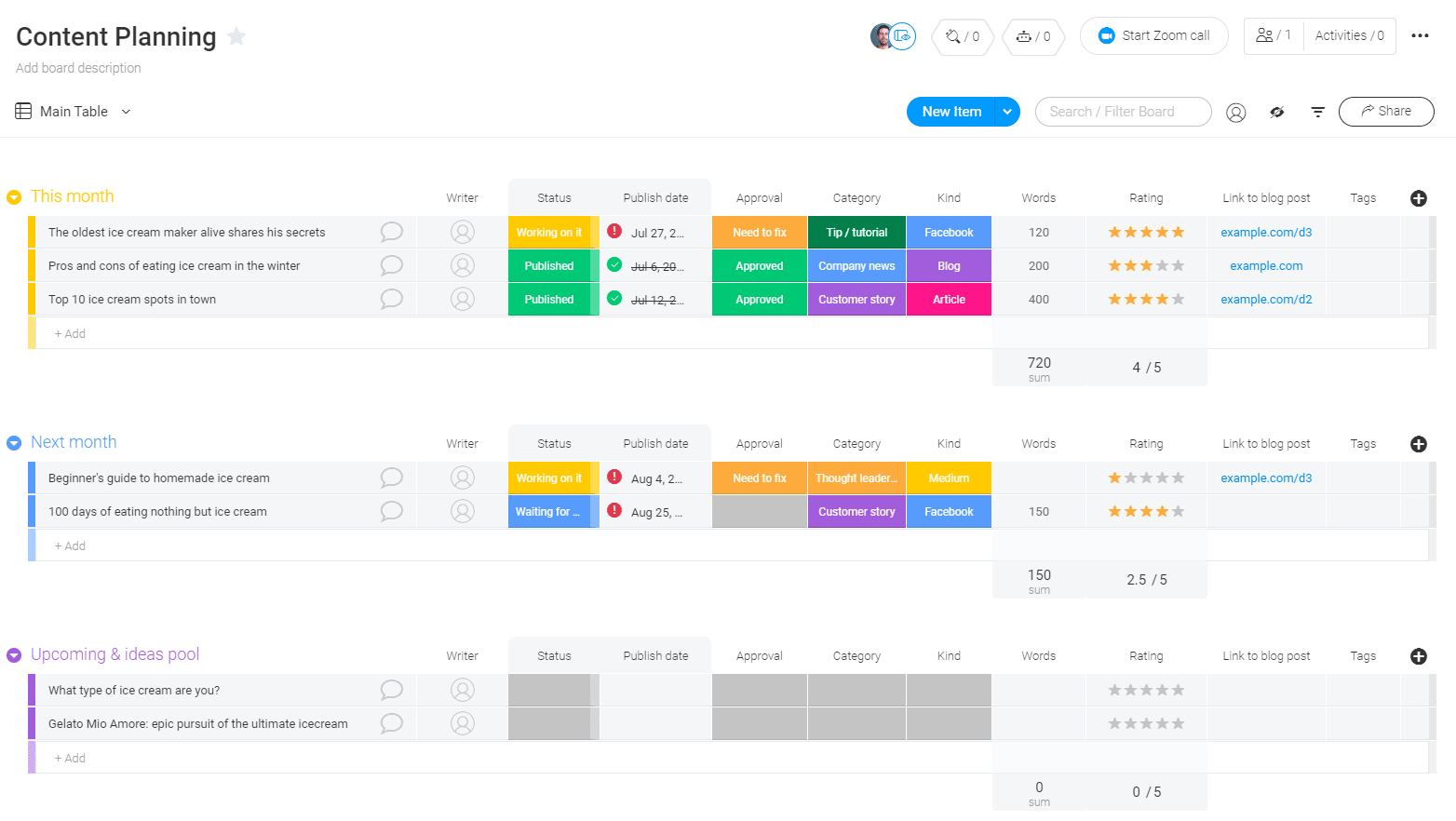
The monday.com content calendar template, above, shows how this can work. By adding custom columns into the scheduling document, you can make it easy for anybody to find what they need, when they need it.
2. Support the sales team
Like all your client-facing operators, your sales team needs access to digital assets in order to do their jobs. Brand assets can capture leads, grease the wheels of meetings, and get prospects off the fence.
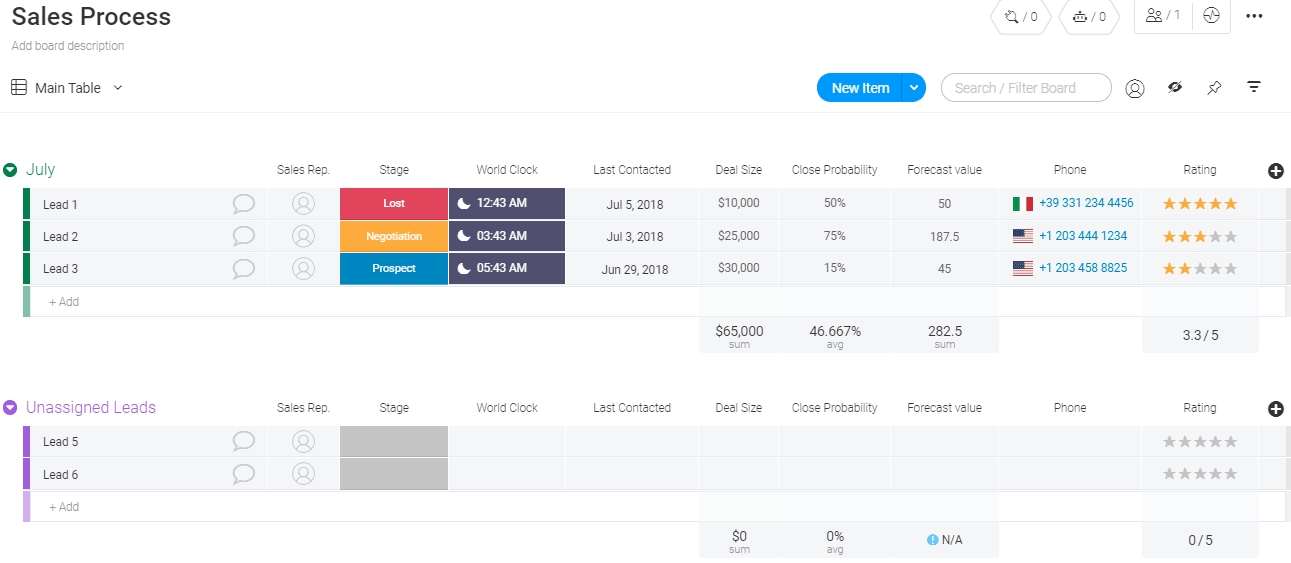
The monday.com CRM template tracks how well deals are going with potential clients.
Through our Work OS, you can also link it to your digital asset storage, tracking at a glance which sales reps are working with which assets.
That way, when an asset or its metadata needs to be updated, you can instantly inform every rep that needs to know.
3. Help your customers
Digital assets aren’t just for marketing. They can also promote better customer experiences.
Digital text, images, audio, video, and rich media assets can guide your new customers through onboarding. You can provide branded tech support and introduce them to new features they might want to upgrade to.
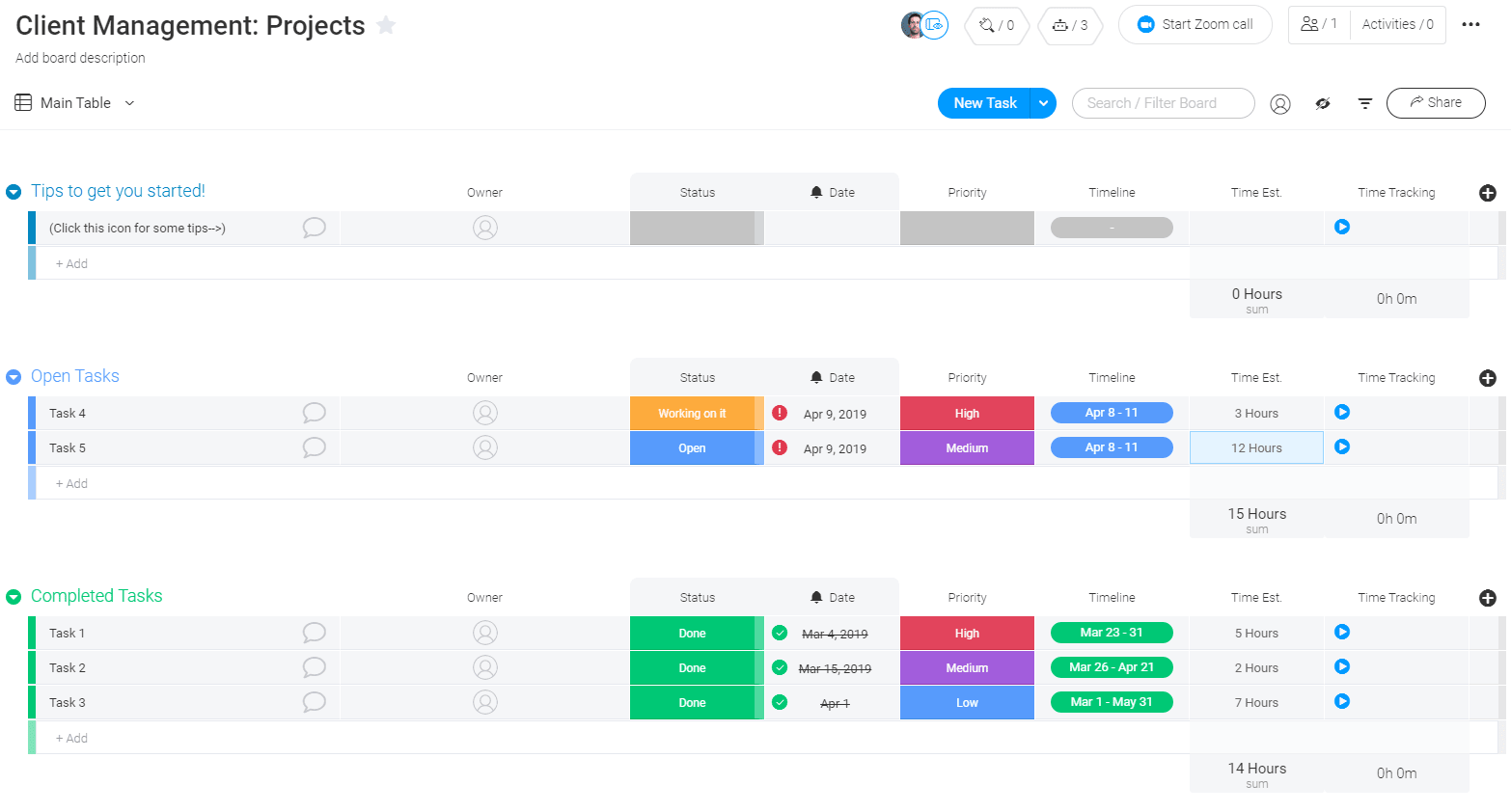
Just like with the sales team, you can level up your digital asset management by linking it to the dashboard where you track client-facing work.
If any of your clients could benefit from digital assets, link to them in a new column. Now their account manager can get at them with a click.
4. Help with video content production
Video content is incredibly popular lately, but it’s also a massive time sink — unless you have a process in place to get it done fast.
Branded videos vary in how elaborate they are. One marketing team might go for full-on movie productions, while another marketer keeps it simple so customers can watch on their phones.
Either way, you want branded assets in the video. That means logos, links, infographics, tutorials, and more.
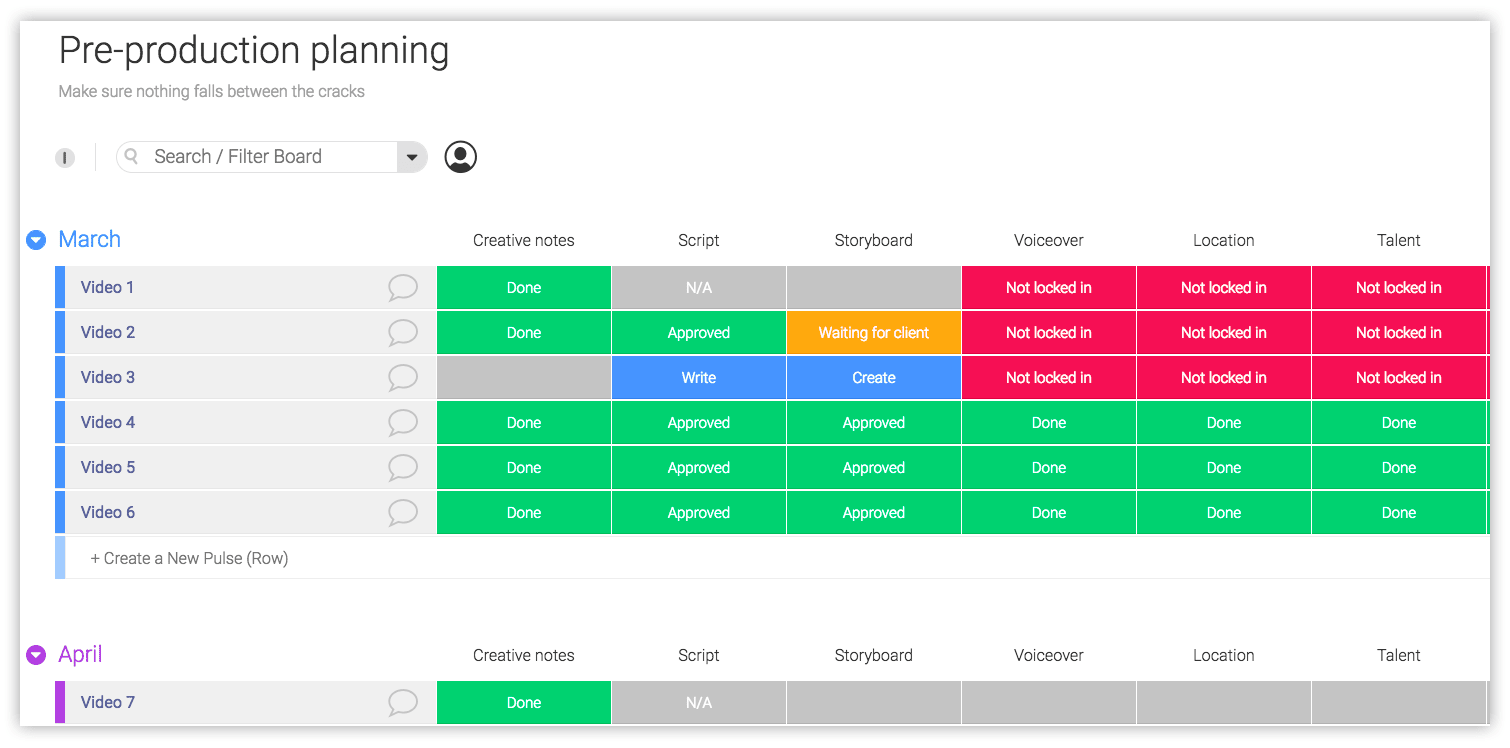
In the monday.com video production management template above, you can link each video directly to the digital assets it requires.
Digital asset management cuts down on the time it takes to produce a video by placing the component parts at everyone’s fingertips.
5. Automate content deployment
Remember the content planning template we showed you back in use case 1? Take another look.
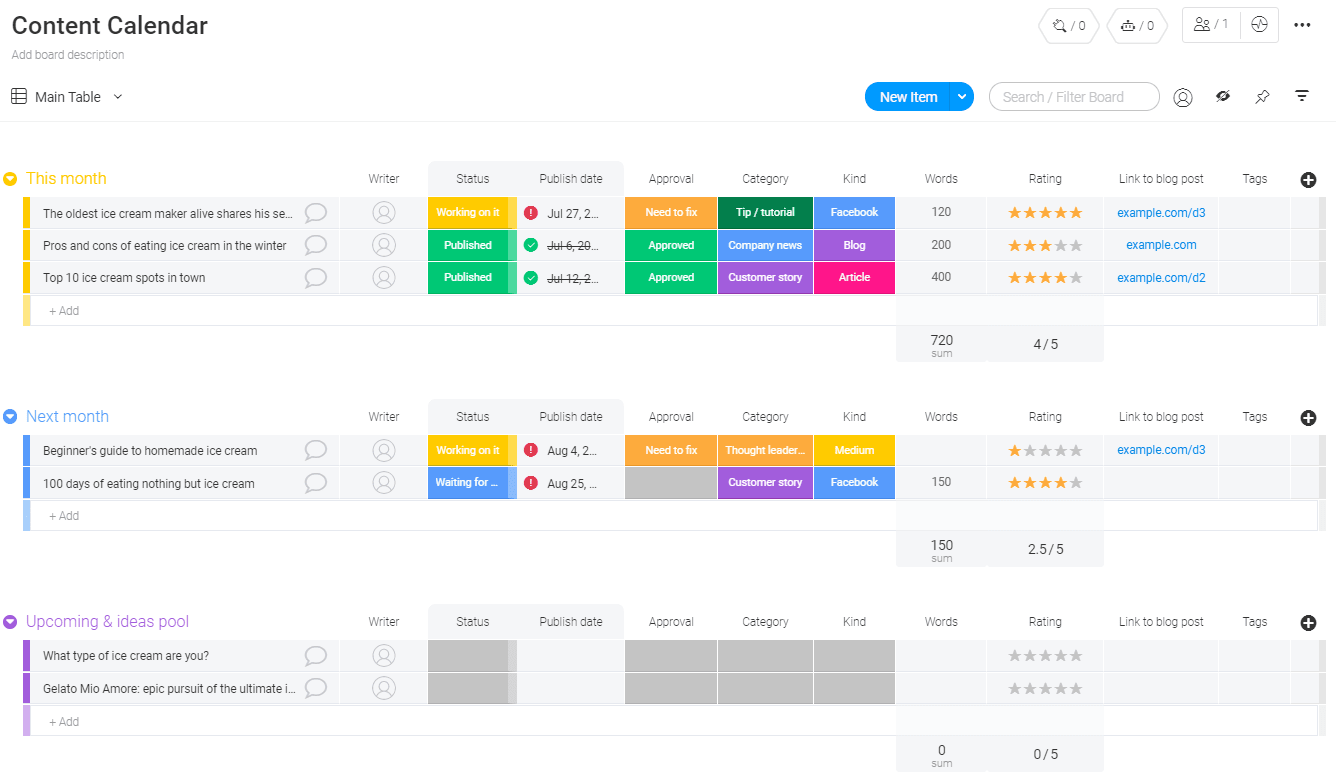
With a bit of customizing, you can build a content deployment calendar linked directly to your digital asset management solution.
Here’s how it works:
When you’re finished developing or updating a digital asset, store it in the database where it belongs.
At the scheduled time, the content calendar automatically retrieves it and posts it to your website without you lifting a finger.
That’s what we mean by a custom DAM system. Pretty cool, right?
Content deployment is an oft-overlooked time sink for creative teams. By automating it, your creatives can get more hours in their days.
6. Get omnichannel analytics
One of the great things about digital asset management is that it’s not just about data flowing from you to your customers. That data also flows back to you.
Setting up your digital assets in a database means you can keep track of them, even when they’re out in the world.
That means you can track how well each one is doing — in views, interactions, successful conversions, or other metrics — from a central location. You can build data-driven marketing campaigns that maximize returns. You should also understand and be able to track all the costs associatedwith the creation and distribution of your assets.
Check out how monday.com can help you with basic reporting.
7. Protect sensitive assets
Don’t read us wrong; cloud storage is a dream come true for mostly-online businesses. But it can be a nightmare if you approach it carelessly.
However you choose to handle digital asset management, it should protect your data from 2 kinds of threats: external and internal.
To guard against internal threats, a good DAM system should let you control who has permission to access what assets. We know you trust every member of your team, but a basic level of caution never hurts.
For external security, your DAM solution needs to encrypt any digital file you put in the cloud, making them impenetrable to hackers.
monday.com uses uncrackable AES-256 encryption to protect everything you store on our platform. Visit our trust center to learn more.
What is the top digital asset management software?
We’ve been mentioning monday.com a lot, because we’re kinda proud of it… OK, more than ‘kinda.’
We knew early on that we couldn’t make the best DAM software to manage your creative requests — because “best” is different for everyone.
Instead of trying to force a workflow onto you, we’ve handed you everything you need to make your own workflows.
monday.com is fully customizable so that you can configure whatever digital asset management system will work best for your business.
To learn more about how you can set monday.com up as a digital asset manager, check out this short video:
Time to get started
Businesses can’t ignore online content marketing anymore.
That’s becoming a cliche, but just because something is cliche doesn’t mean it isn’t true. Like “always brush your teeth” or “you can’t eat gummi bears for lunch AND dinner.”
The best time to build a digital asset management workflow is yesterday. The second best time is now.
It’s how your company can ride the wave of digital content to consistent long-term customer engagement.
Using monday.com, you can build an enterprise-quality DAM system that’s bespoke for your needs. We can’t wait to see what you come up with.

